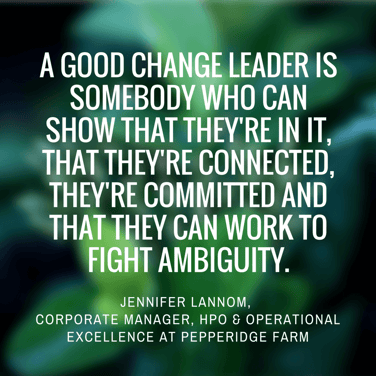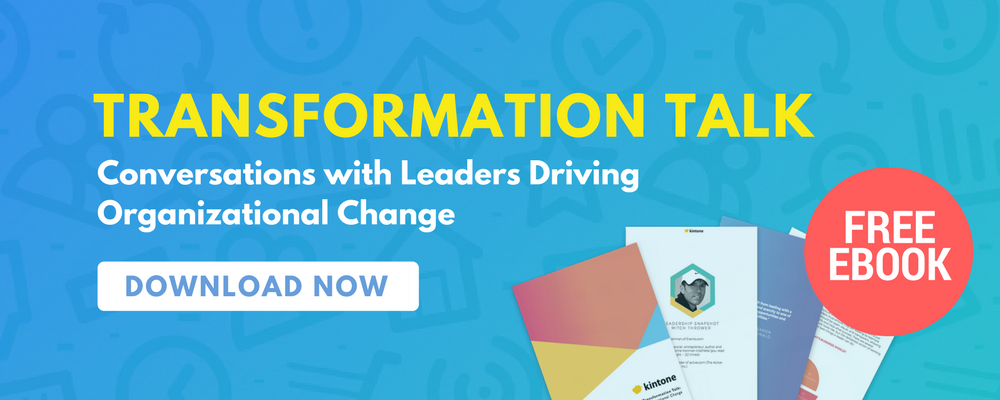Pepperidge Farm is responsible for producing iconic brands such as Milano cookies and Goldfish crackers, but also a culture of high employee engagement.
Jennifer Lannom, High Performance Organization (HPO) and Operational Excellence Manager for Pepperidge Farm, knows firsthand. Her unique career trajectory in continual process improvement, human resources and operations management have proved useful for creating a corporate culture that fosters better employee engagement.
And she and her team are ahead of the game.
A 2012 study by Gallup called "The State of the American Workplace" found that only 30% of employees in surveyed companies were “engaged” in their companies’ business, with 52% “not engaged” and 18% “actively disengaged.”
Employee engagement is more than just creating warm and fuzzy feelings – it has a real impact on retention, productivity and even a company’s operating margins.
Aon’s 2015 Trends in Global Employee Engagement report reveals consistent relationships between higher levels of employee engagement and financial performance. In previous studies, the group found that a 5% increase in employee engagement is linked to a 3% increase in revenue growth in the subsequent year.
One of the key factors in the engagement equation is how companies are structured and managed.
In this Transformation Talk, Jennifer shares how her holistic improvement approach has turned Pepperidge Farms into a high performance organization with engaged employees.
Kintone: What skills have prepared you for your current role at Pepperidge Farms where you are currently helping eight plants transform into towards high-performance teams?
Jennifer Lannom: Having an operations background is very important especially if you're talking about any kind of initiative where you're looking to bring change.
When I was previously working in human resources, having operations experience and actually knowing what it's like to be there working on the floor or working as a supervisor, was enhanced with my HR perspective.
I look at things much more from an operations and continuous improvement perspective, but I also have the human resources skill set to try to look at what we need to do. How can we make a change initiative work from a human resources perspective? Just having the background really supported that, and, of course, having worked at companies that embrace operational excellence and gaining that experience supported me in understanding how to set up human resources systems to support all of that.
Do you have any memorable experiences when you felt like all of your combined experiences served you and your team well?
JL: For sure. When I was working at our Aiken facility, we were moving from a traditional environment to the high-performance teams. And I was excited every day to go do the work. It was in that environment where we started moving from the traditional systems toward self-directed work teams. It was the perfect culmination of my skills to help make the transformation possible.
What’s some advice you’d give to people transitioning from a predominately top-down hierarchical organization to one with more engaged, self-directed teams?
JL: Start by having a vision that people can get excited about – something that gets people out of bed and want to work extra hard for. It's got to be something bigger than ourselves. As a leader, you have to be very committed and excited about a vision that you're going after with a team. We may not have all the answers, and we may not know how to get there, but we're going to get there, and we're going to do that as a team.
When I was working at the Aiken plant, I helped people understand and get excited about that vision, because it was so different from what we were currently doing. It wasn't easy. There's nothing like having people go and see what it looks like in action. So, we sent everyone in that plant on a benchmarking trip to other companies to talk to operators who were going through a similar transformation. Our people would come back and say they're excited and to me, that made the biggest impact as far as helping people see what was possible and that this wasn't just something crazy that we came up with.
What skills does someone who’s leading a change initiative need?

JL: A good change leader is somebody who can show that they're in it, that they're connected, they're committed and that they can work to fight ambiguity.
It's not about somebody creating a big plan and having everything already figured out already. It should be the other way around and having people part of the decision-making to help things move forward. But that change leader just being there to support, being a servant to the team, providing them what they need, the emotional support and the resources, whatever it is that they need to make that happen is most important.
What can leaders do to manage resistance to change?
JL: Well, I made this mistake, I'll tell you, more than one time. When I see people who aren't excited about a change initiative, I would go spend my time with these people and convince them it was a good thing. But it may not always be a good use of time.
When you're trying to convince these people, it's like the Pareto rule (the 80/20 rule). It's been shown that if you can get 20% of your population on board and excited about what you're doing, the other 80% is going to make decisions on their own. The majority are going to jump on board as well when they see you've got 20% going in this direction. Then you're going to have a few who might fall out, but the things is, if you focus on that top 20% who are super excited about what's going on and give them the resources, then the rest of the group will start to come on board. The bottom few may just have to make some decisions around what they want to do -- if they want to be part of this or if they prefer not to be.
So I’ve learned, if you focus on the ones who don't want to do it, and meanwhile, you've got the 20% sitting around waiting. "Okay, we're excited. What do we do next?" then you're not capitalizing on that spirit and that energy. It's really important to focus on the people who are also excited and committed. The rest will start to work itself out.
Sometimes there can be people who are detrimental to the change. Even giving them ownership of something that's happening with the change can help turn them around which really helps those other resisters say, "Oh, my goodness, if this person jumps on board, there must be something worthwhile with this."
RELATED: How Radical Self-Awareness Won Over Employees And Transformed An Organization
What skills would be of the utmost importance in the agile workplace?
JL: The ability to coach others. Creating learning organizations is important today and will continue to be important. Learning organizations are agile. They're able to pick up things very quickly and move nimbly.
But you have to be able to coach well. You have to be able to make decisions quickly and have decision-making processes and skills to work with ambiguity. The stronger a leader is able to do that, the stronger an organization you're going to have because if everyone is doing that, your people continually grow and continue to be more capable.
It helps when there’s less and less structures of hierarchy to make room for grouping people around the work that needs to be accomplished. It reduces the number of silos and it makes things much more fluid.
-------------
Do you know someone who’s particularly fantastic at business transformation? Is a master of change management? A leader in teamwork? Nominate them — or better yet, nominate yourself (c’mon now, you’re awesome!) to be featured in our Transformation Talk series. Just send Nicole an email:nicole@kintone.com. Or send us a message on Twitter @Kintone.
About the Author
Nicole is Director of Marketing at Kintone, with 10+ years experience in content strategy, campaign management, lead acquisition and building positive work cultures of empowered, purpose-driven team members. She spent seven years as a journalist, previously serving as a CBS San Francisco digital producer, NPR contributor, Patagon Journal deputy editor and reporter for several publications, including the Chicago Tribune. She's passionate about the tech for good space, social entrepreneurship and women leadership. On the weekends, you’ll likely find her putting her Master Gardener skills to use in at community gardens in Oakland.












